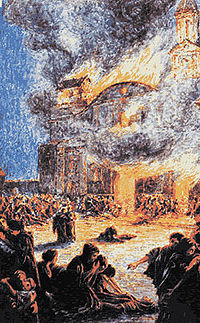- Church of the Company Fire
-
The Church of the Company Fire (December 8, 1863) is the largest fire to have ever affected the city of Santiago, Chile. Between 2,000 and 3,000 people died, and it is considered one of the worst fire disasters in history.
Contents
Events
The Church of the Company of Jesus, (Spanish: Iglesia de la Compañía de Jesús) was a Jesuit church located in downtown Santiago, closely associated with the Marian cult. That day was the celebration of the Feast of the Immaculate Conception, one of the most popular festivities of the religious calendar, and the temple was adorned with a profusion of gas lights and wall coverings. In the main altar, a large statue of the virgin Mary stood over a half-moon that in itself was a huge candelabra.
That night, the fire started a few minutes before 7 PM[1], when a gas lamp at the top of the main altar ignited some of the veils that adorned the walls. Somebody tried to put it out by smothering it with another cloth, but managed to only make the fire jump over to the rest of the veils and from there on to the wood roof. The mostly women attendees panicked and tried to escape but the side doors had been closed in order to leave space to accommodate more people (they only could be opened inwards), leaving the main entrance as the only exit. Upon being notified of the tragedy, U.S. Envoy to Chile Thomas H. Nelson rushed to the scene and assisted in rescue operations. Several days after the fire, Nelson was recognized as a "true hero of Chile."
The big hoop skirts worn at the time made escape very difficult if not impossible, causing the people at the front to fall down and to be trampled by the ones behind. Very soon the main entrance was blocked by a human wall of bodies, impeding both the exit of the ones trapped inside, and entrance to the rescuers. The main tower of the church was built of wood (while the rest of the church was solid masonry) and finally collapsed inwards around 10 PM[1], putting an end to the few remaining survivors.
Aftermath
Between 2,000 and 3,000 people perished in the fire, in a city that at the time had about 100,000 inhabitants. Entire families were wiped out. The clean-up of the bodies took about ten days, and since most of the bodies were burned beyond recognition, they were placed in a mass grave at the Cementerio General de Santiago. The remaining walls of the church were torn down, and a garden was planted in the place, with a statue placed at the site where the main altar used to be. The garden and the statue still exist. At present the statue is part of the old Congressional gardens. A copy of the statue is located at the main entrance of the Cementerio General de Santiago. The Church bells were sold for scrap and recovered and made their way to Oystermouth, Swansea, Wales, where they are still used today for calling people to worship. A consultation is being considered for their return to Santiago.[2]
The tragedy, and the fact that one of the contributing factors was the lack of an organized fire-brigade, motivated José Luis Claro y Cruz, to organize the first Volunteer Firemen's Corps in Santiago, on December 20 of the same year. Fire brigades in Chile, even today, are still made up only of unpaid volunteers.
See also
References
- ^ a b The New York Times, January 18, 1864
- ^ "Church bells to return to Chile". BBC News. February 8, 2010. http://news.bbc.co.uk/1/hi/wales/north_west/8503683.stm. Retrieved 2010-02-08.
External links
Categories:- 1863 in Chile
- 1863 fires
- Fires in Chile
- History of Santiago, Chile
Wikimedia Foundation. 2010.


